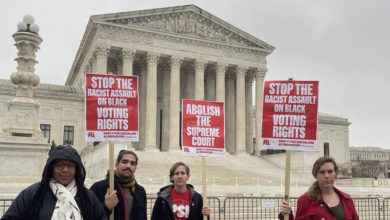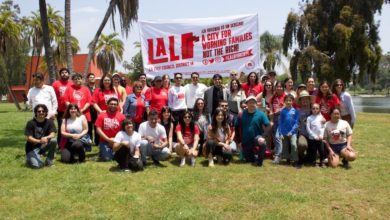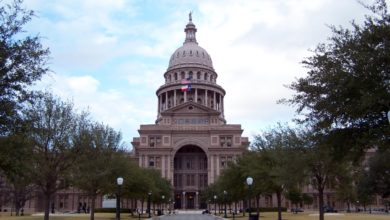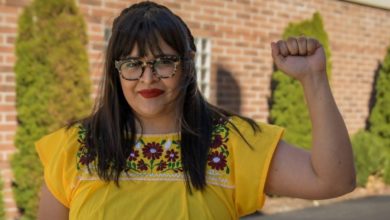This article was written by a member of the Party for Socialism and Liberation who participated as an election observer in the June legislative election in Mexico at the invitation of the Morena party.
Within minutes of arriving at the first polling place in the municipality of Iztacalco in Mexico City, many in line to vote immediately focused their attention on our delegation of international observers from the United States and Latin American and European countries. One voter noticed our badges issued by the National Electoral Institute (INE), and protested that our presence was an irregularity and violated the electoral process. In another moment, an elderly man from Iztacalco received us with joy, addressed the comrades who came from Bolivia and Venezuela, and exclaimed his great support for the revolutionary processes in those countries.
On one side is the Morena movement, which in 2018 took presidential power for the first time. Morena — the National Regeneration Movement — is the party of Mexican president Andrés Manuel López Obrador, popularly referred to as AMLO. Morena’s victory was a historic defeat for the neo-liberal Institutional Revolution Party (PRI) that had ruled Mexico for over 70 years, as well as the conservative National Action Party (PAN).
On the other side is the opposition. This year the PRI and PAN formed a coalition of right-wing neoliberal parties to try to stop the Morena movement. Their political program is that of continuing capitalist neoliberalism of the last decades that has caused so much devastation and suffering in Mexico.
The Fourth Transformation
We were guests of Morena to observe the mid-term elections that took place on June 6. At stake were the 500 seats in the Chamber of Deputies, 15 governorships, and thousands of mayorships across the country. Morena leaders and militants on the eve of the elections emphasized repeatedly that these would be the most important elections in Mexico’s history and fundamental to undertake the “Fourth Transformation” (4T). One of those requisites for the 4T would be a super majority of the deputies, or 333, to pass constitutional reforms.
Mexico was one of the first countries in the world to officially abolish slavery. Shortly after the famous Grito de Dolores by Father Miguel Hidalgo, the war of independence against Spain led by Afro-Mexicans Jose Maria Morelos and Vicente Guerrero proclaimed the liberation of slaves in 1821.
According to Morena leaders, the first transformation begins with the above-named war of independence in 1821. The second transformation was at the beginning of the War of Reform in 1857, culminating with the administration of Mexico’s first Indigenous president Benito Juárez. The third transformation refers to the Mexican Revolution in 1910, which put an end to the country’s dictatorship and brought about profound social reforms. That third transformation included major reforms in the 1930s such as the nationalization of Mexico’s oil and other strategic industries.
The Fourth Transformation has begun many of the promises made by Obrador and Morena. Since 2018, they have managed to pass the Hydrocarbons Law to stop the further privatization of the energy sector, and to favor the state enterprise PEMEX over foreign investors. Currently the Hydrocarbons Law is held up by court and investors’ challenges. The minimum wage has increased by about 45%. Taxes increased for large corporations.
Obrador has implemented several laws and reforms that not only affect government representatives, but his own mandate. The presidential immunity that shielded heads of state from being tried for crimes was eliminated. And a new law was implemented on the revocation of mandate and popular consultation, which attempts to evaluate the work of the president mid-term.
Another of Morena’s achievements is guaranteeing the constitutional right to a pension for all people over 68 years old. This same law also guarantees scholarships for students from low-income families from preschool through university. Finally, also included in this reform was access to free healthcare for people who do not have social security — almost half of the country. These reforms were made possible not only by AMLO’s presidential triumph but also by the legislative majority they obtained in 2018.
AMLO’s first act was to ensure gender parity in his cabinet by selecting an equal number of women and men for the mandate. He established daily presidential morning conferences to report on the progress of the administration and to answer questions from the press. There have been many challenges and contradictions encountered during Obrador’s time in office, and the economy overall remains firmly in the hands of the capitalist class, but the “Fourth Transformation” represents the strategic vision of the movement that swept him into office.
Iztapalapa: a utopia made reality
It was the day before the elections and our Morena comrades told us that we were going to one of the “Utopías” in the municipality of Iztapalapa. The trip was not long and we arrived at the town in less than 20 minutes. Upon entering the main street called Avenue San Lorenzo, our delegation immediately pulled out their cameras and cell phones to take pictures of the long string of walls that adorned the street with powerful images of women and many of Mexico’s Indigenous peoples along with messages of empowerment. Another characteristic of this street was a seemingly-eternal row of light poles that were installed to illuminate the avenue. A representative of the mayor’s office of Iztapalapa explained to us that these streets are on several main avenues in Iztapalapa and are named “Calle de mujeres libres y seguras” (Street of free and safe women).
The project is part of the recovery of streets and public spaces in Iztapalapa. It was built with the approval and participation of the community. Before 2018 the street was not completely paved and poorly lit. It was known as a very dangerous street for women, who were subjected to daily harassment and violence.
Iztapalapa is an original people’s town in Mexico. The majority of Iztapalapa’s inhabitants are migrants from southern Mexico, such as Chiapas and Oaxaca, who migrated to Mexico City in search of work. This internal migration is the result of decades of neoliberal laws such as the North American Free Trade Agreement (NAFTA), which has been largely responsible for the exodus.
Our tour of several streets in Iztapalapa revealed that the majority of its inhabitants were low-income workers and Mexico’s poor. The town has a dense population with water supply problems and other difficulties, but the moment our transportation arrived at the parking lot of Utopía Tezontli it seemed we had been transported to a country club or private recreation area in one of Mexico’s wealthiest neighborhoods. But no, Utopía Tezontli was in the heart of Iztapalapa and unlike a country club, access was completely free and open to all residents of the municipality.
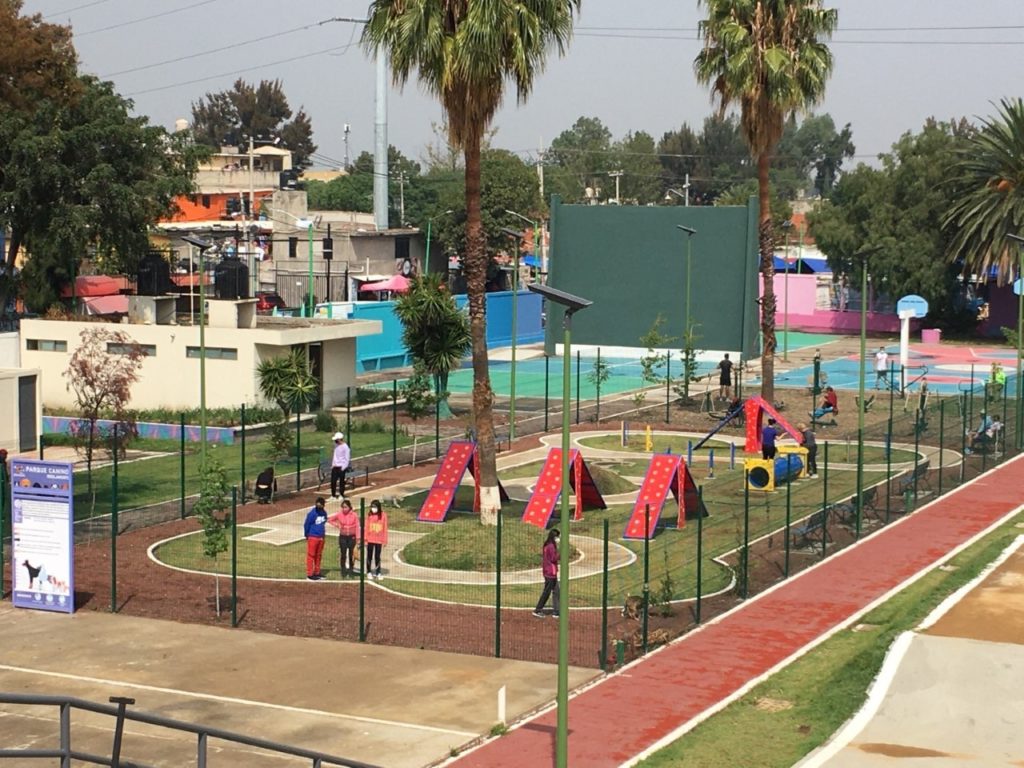
The Utopías are a project of the Iztapalapa mayor’s office led by Mayor Clara Brugada, a Morena militant who took office in 2018. The project is central to the recovery of public spaces to provide infrastructure and higher quality services to the population. The Utopías are recreational areas that include natural grass soccer fields, a dog park, BMX tracks, Olympic swimming pools, gymnastics and dance classes, music rooms, and a theater for 400 people, among others. There are also completely free public service facilities including non-judgmental rehabilitation centers, mental health services, arts and computer workshops, senior housing, among others, completely free of charge.
Today there are eight utopias in the municipality of Iztapalapa alone, with six more under construction. The largest is 100,000 square meters. The tour of the facilities made it clear that the project has given this previously forgotten community an area where they can perform their physical activities, obtain essential resources, and explore their talents and learn. Although many of the institutional problems such as inequality and lack of water supply continue, at least the community now has a high-quality venue of their own, free of charge.
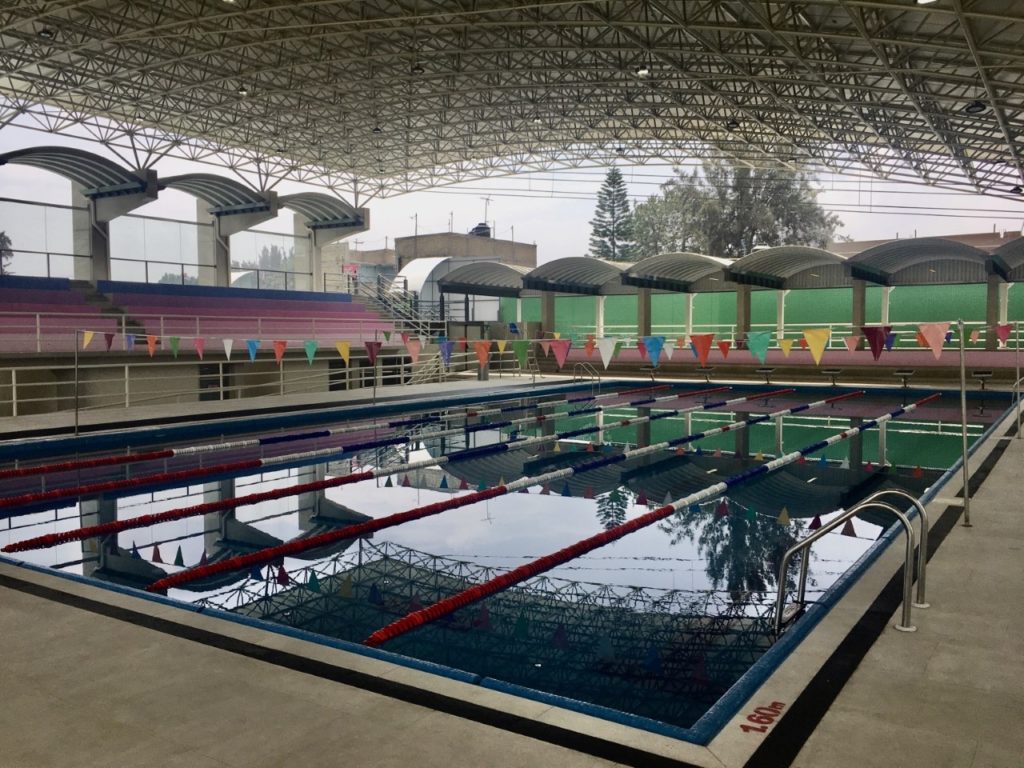
Morena: half movement, half party
A message frequently repeated by Morena representatives during my visit was the complex identity of Morena as half movement and half party. In the book “A Year of the 4T” by Armando Bartra, he explains the movement’s desire to count not only on the popularity of AMLO in the country to advance the movement. They fear that concentrating the face of the party on AMLO at the expense of the organization itself would be a mistake that would put them in a vulnerable position.
On the second day of our journey in Mexico, I had the opportunity to attend a panel entitled “Youth and Feminists.” We heard talks and discussions from several young Morena leaders, most of whom were women, about how proud they were to represent the party and its mass organizations. One of these organizations is the 4T Feminist Committee. This organization led by women party militants is in charge of popularizing feminism as a fundamental part of the Fourth Transformation.
One of its main activities is community door-to-door outreach, and enforcing a requirement that all candidates and government officials affiliated with Morena commit to implement a popular feminist agenda. Many fruits of this work are already evident. Morena is the first gender-parity government in the history of Mexico, and the first party with a sexual diversity secretariat.
Morena at the national level is a coalition of several political forces, mostly from the left. Morena does not present its program for Mexico as a socialist project, but rather one of opposition to the neoliberal and right-wing path that Mexico has been following for many decades now.
AMLO and Morena have also played an important role in Latin American regional politics. Since coming into power, AMLO’s administration has moved away from the anti-Venezuela “Lima Group” and shown solidarity with Venezuela and Bolivia in particular. He refused to sign a statement by the Lima Group calling the 2018 Venezuelan presidential election of Nicolás Maduro a fraud, and condemned the 2019 failed U.S.-engineered Guaidó attempted coup against president Maduro. In Bolivia, he not only denounced the right-wing coup against former Bolivian president Evo Morales, but also offered him asylum — saving his life and paving the way for his eventual triumphant return home.
The partial referee
On election day, we made a long tour of several polling stations in different municipalities of Mexico City. We visited four municipalities: Iztacalco, Benito Juárez, Coyoacán and Magdalena Contreras. We observed few or no incidents in most of the polling places we visited. But in two polling places in Magdalena Contreras, we did witness vote buying within 50 feet of the entrance to the polling places.
The vote buying was evident as several people after voting would walk up to individuals carrying folders and verify with what we assume was a phone photo that they voted for their candidate. Our delegation immediately informed INE representatives of the violations we observed. The INE representative said he already knew what they were doing but that it was out of his jurisdiction as long as they did it outside the polling station.
The opposition was responsible for the majority of electoral violations and irregularities such as vote buying, acarreo (practice where voters are forcibly transported or encouraged to vote for a candidate for something in return), voter suppression, and allying with criminal sectors to intimidate voters. During the electoral campaign, 34 candidates were assassinated by organized crime. The crisis of mass executions and extreme violence fueled by narco-trafficking has weighed heavily on the population.
In the second polling place we visited in Iztacalco, we saw a huge line that ran the length of the block. This polling station was reserved for Mexicans from other states or who are far from their home where they are registered to vote, but we met a crowd of people complaining about not being able to vote.
Although INE is an institution independent of any political party or the government in charge, Morena representatives have denounced INE as a biased arbiter. One of the goals of the AMLO administration is to reform INE.
What the results mean for Morena and Mexico
As the first preliminary results came out on election night, the right-wing corporate media immediately began to spin a narrative on the results. Morena leaders point to the disinformation campaign by the right wing and the information bias of the corporate media as the main reasons for Morena not achieving the resounding victory they were expecting. However, Morena still won most of the seats that were up for grabs in the election.
Morena’s poor performance in Mexico City was the big surprise of the election. This is the first in a long time that the right wing has won in Mexico City, the epicenter of the Mexican left and the place where many progressive social changes have been achieved such as the right to abortion and respect for sexual diversity.
Morena, because of its party-movement characteristic, attracts several political forces not only from the left but also opportunistic figures from the center and even from the right. Many argue some of Morena’s losses in Mexico City and the rest of the country are the fault of Mario Delgado’s management as president of the party. Delgado is an economist and professional politician who represents the right wing of the party.
Delgado became Morena’s president at the behest of the party’s leadership after a long, drawn-out power struggle. Delgado is not a beloved figure by the majority of party militants for the role he played in the passing of former president Enrique Peña Nieto’s privatization of the energy sector, when he still belonged to the Democratic Revolutionary Party (PRD).
But the losses are also attributed to the battle over the future of Mexico’s struggling petroleum industry, with the PRI/PAN/PRD opposition arguing for continuing the “modernization” of PEMEX through foreign investment. This helped to galvanize much of the capital’s middle class to vote for the right-wing coalition.
Now that the elections are over, Morena’s next task internally is one of reflection. Leaders and militants plan to demand that the party’s leadership engage the mass movements where its most dedicated militants come from to change and grow the party.
Still, Morena won 12 of the 15 governorships that were at stake in these elections. With the six it already had, this gives it a majority of 18 of the 32 national governorships. There are some governorships that the opposition officially won but are being challenged. Although the right wing won 9 out of 16 municipalities and demarcations in Mexico City, at the national level Morena won 692 municipalities or mayorships compared to the 495 it won in 2018.
Although Morena lost seats in the national legislature and could not achieve a super majority of 333 deputies needed for the constitutional reforms that it is seeking, it still maintains the majority needed to pass operational reforms and the national budget.
The day after the elections and with the official results already published, the obstacles could not dampen the optimism and will to resist of the Morena comrades who accompanied us during our visit. Many of them immediately began to reflect on how they can improve their work for the people.


